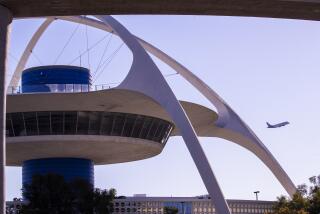On-Job Air Traffic Training Halted in L.A. After Errors
- Share via
A rash of potentially dangerous mistakes by air traffic controllers at the Los Angeles Air Route Traffic Control Center in Palmdale has prompted a halt of on-the-job training of less experienced personnel so veteran controllers can concentrate on doing their jobs, a Federal Aviation Administration spokesman said Wednesday.
The suspension of the training at the center will continue until Feb. 28, FAA spokesman Russell Park said. The Palmdale center controls traffic over 180,000 square miles of airspace across southern Utah, southern Nevada, western Arizona, Southern California and a stretch of the Pacific reaching 200 miles out to sea.
The latest staffing figures released by Don Early, traffic manager at the facility, indicate that as of Nov. 1, there were 326 full-time controllers at Palmdale. Of these, 166 were veteran, “full performance level” personnel, fully qualified to work any of the control positions at the facility. The remainder were “developmental controllers,” fully qualified to work some, but not all, of the control positions.
Before Monday’s suspension order by Early, 71 of the veteran controllers were spending up to 4,000 hours a month training developmental personnel, Parks said.
During such training, the developmental controllers assumed the position of primary radar controller, monitoring aircraft on the radar screen, communicating with pilots and making all major control decisions. The veterans served as observers, assistants and backups.
With the on-the-job training suspended, the roles essentially will be reversed.
Parks said the FAA is looking into eight incidents involving possibly serious errors by controllers at Palmdale since Jan. 1.
One involved a near miss last Friday between an AirCal Boeing 737 jetliner and three military jets about 20 miles southwest of Los Angeles International Airport, Parks said. The AirCal pilot reportedly told investigators he was following a controller’s instructions to climb to 13,000 feet when he saw the military planes pass about 1,000 feet overhead.
Another incident occurred Jan. 1, when a TWA jumbo jet and an Air New Zealand Boeing 747 passed too close to one another.
Parks said six controllers involved in the two incidents have been relieved of their operational duties pending completion of the FAA investigation.
More to Read
Inside the business of entertainment
The Wide Shot brings you news, analysis and insights on everything from streaming wars to production — and what it all means for the future.
You may occasionally receive promotional content from the Los Angeles Times.










